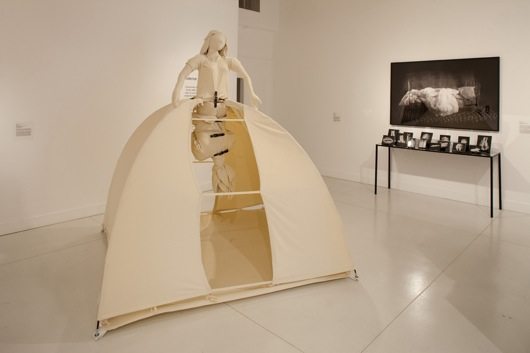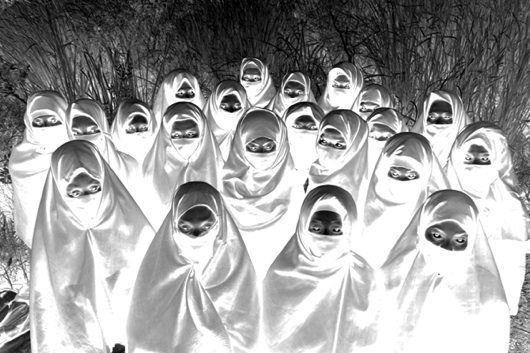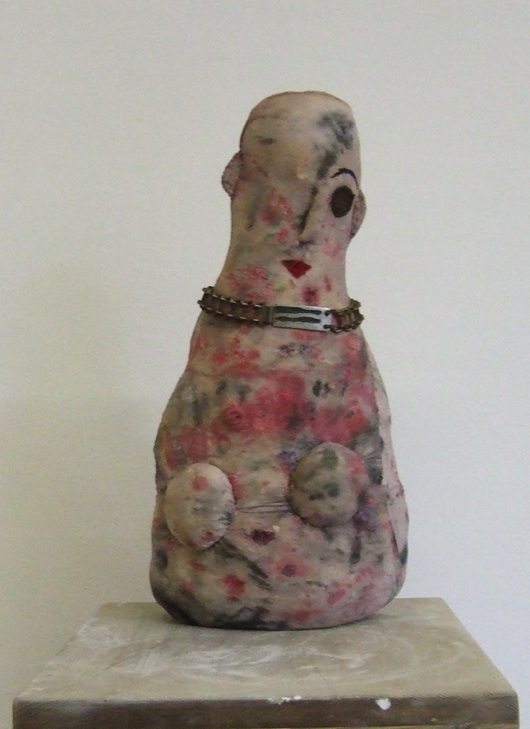Location: US, Rwanda, Bosnia, South Africa

MILLIONS OF PIECES: ONLY ONE PUZZLE, Antonia Briceno, UN Environment Programme, World Environment Day 2010 exhibition in Rwanda
INTRODUCTION
I’VE BEEN EXPLORING THE ABOVE QUESTION THROUGH many lenses my entire professional life. From the personal to the political, I’ve worked to learn how art can be an effective means for engagement and enlightenment – all while maintaining the highest artistic integrity. It’s been a challenging, but a very satisfying, journey.
Twelve years ago, in 1999, I moved to California, leaving behind my established business as an independent contemporary art curator and consultant in Washington, D.C. My engagements there included a 10-year-run as the curator for The World Bank and the International Finance Committee; curator for the Carnegie Endowment for International Peace; and consultant for a number of other corporate, institutional, and government art collections.
With my combined background as an exhibiting artist as well as an art therapist (I hold Master’s degrees in both disciplines), my orientation to art has always been from a psychological and symbolic point of view. Prior to my work as a curator, I worked as an art therapist at the National Institute for Mental Health, part of the U.S. National Institutes of Health, at a time when psychoanalysis was the prevailing framework. We used art as a diagnostic tool within psychiatry and as part of research programs. My background led to a cultivation and enjoyment of exploring and analyzing the meaning and messaging in art, always asking ‘What is being communicated and how through the medium of art?’
This question has been my professional thread for nearly 30 years, whether helping adult alcoholics seek self-awareness through art therapy or helping The World Bank build an art collection that reflected — literally, metaphorically and symbolically — its 175 member countries.
Although I had a very good business in Washington, I was happy to embark on a new adventure in the San Francisco Bay Area. One of my first projects there was to curate and produce an exhibition for the Committee of 100 for Tibet and the Dalai Lama Foundation, on the ideals and vision embodied by the Dalai Lama. The resulting exhibition, ‘The Missing Peace: Artists Consider the Dalai Lama,’ included such art luminaries as Laurie Anderson, Bill Viola, Marina Abramovic, and Jenny Holzer, along with 67 other artists. It opened in Los Angeles in 2006 and traveled to 10 cities over the next five years — including Chicago, Madrid, Tokyo, Stockholm, New York, Austin, and San Francisco — before closing in mid-2011.
In the mid-late 2000s, I had the great fortune to curate exhibitions for other global organizations. Among them was the United Nations Environment Programme, which produces World Environment Day annually, hosted in a different city each year, each featuring an art exhibition on that year’s theme. My exhibitions focused on climate change, melting icecaps, urban environments, and ‘unlearning intolerance,’ and traveled to Oslo, Brussels, Monaco, Wellington, New York, Chicago, San Francisco, and other cities. Again, I was selecting artworks that were strong aesthetically and in their messaging around the themes of the exhibitions.
I. OFF THE BEATEN PATH
IN 2008, ONE OF THE ARTISTS IN THE DALAI LAMA exhibition, Mexican-born Susan Plum, created a powerful work addressing the missing women of Juarez. Susan’s project, Luz y Solidaridad (‘Light and Solidarity’), created for ‘The Missing Peace,’ addressed the plight of the women of Juarez, Mexico. It evolved out of her love of her native Mexico, her social activism, and her belief in art as a vehicle for transformation. ‘While creating Luz y Solidaridad, I knew that this was only one seed being planted for a much greater problem globally of violence toward women,’ Susan wrote to me. ‘It has been a dream of mine for many years to participate with others in bringing some cohesive awareness to this global problem.’
Thus began the initial stirrings of a grassroots exhibition, ‘Off the Beaten Path: Violence, Women and Art,’ with the intent of utilizing art as a catalyst to unite people in action and thought, and to empower individuals, communities, and leaders to address the issue of violence against women. The show launched in 2009, with 34 artworks by artists from 25 countries.
The context for ‘Off the Beaten Path’ is this: throughout the world, women and girls are victims of countless and senseless acts of violence. The range of gender-based violence is devastating, occurring, quite literally, from womb to tomb. It occurs in every segment of society, regardless of class, ethnicity, culture, or whether the country is at peace or war. Often, the victim’s only crime is that she is female.
Today, ‘Off the Beaten Path’ is a multi-media international traveling contemporary art exhibition. Its admittedly lofty goals: to promote awareness of the root causes of violence against women, create empathy for women’s stories, foster a dialogue about the pervasiveness of violence against women, and inspire the belief that women and girls can be empowered with new behavioral choices. The project combines the highest integrity of art and storytelling with important social messaging.
It’s hard for some to imagine an art exhibition on this disturbing topic. Some expect to see tabloid and sensational imagery, graphic depictions of beaten women. Instead, we asked artists to create new images of gender-based violence that move us forward rather than recreate the violence, and in doing so, help us feel and understand the essence of the problem, as well as how to move beyond the problem.
Early on, some of the traditional art writers and other media challenged the notion of art as a medium for social change and activism, wondering if it can really have an impact to change the world. In response, a few of the participating artists began to question their own role as artist and activist: Does it need to be defined as one or the other? This question has continued to linger internally with Art Works for Change, evaluating our effectiveness as a change agent and the kinds of projects and artists we pursue.
II. GROWING THE ORGANIZATION
OFF THE BEATEN PATH WAS CONCEIVED INDEPENDENTLY– that is, with no funding, and during 2008, just as the economy collapsed. Suffice to say, it was a difficult time to find a sponsor. I realized that in addition to being curator and producer, I would also need to be the fundraiser. In late 2009, I founded Art Works for Change with the mission to do what, in effect, I’d been doing for years: using the power of art to curate museum-quality exhibitions that address social and environmental issues, with the intent of engendering positive change. We soon had our first venue for the exhibition, in Oslo, Norway, and seed funding from the Oak Foundation, the Lambent Fund and the Global Fund for Women.
Art Works for Change has grown into a small but powerful team, including Alesha Martinez and Greg Lunceford. Since I have worked independently my entire career, Art Works for Change, while a nonprofit, is run in a somewhat organic, entrepreneurial fashion. We welcome new opportunities and embrace them as they catch our interest.
Within our first year, the UN Environment Programme asked us to curate another World Environment Day exhibition, in Kigali, Rwanda, as well as create an exhibition for the United Nations Pavilion at the 2010 Shanghai Expo. Since 2010 was the UN Year of Biodiversity, both of these exhibitions addressed biodiversity. Now, these two exhibitions, supported by grants from Adobe Corporation and SC Johnson, are being combined with additional artworks to create a new traveling exhibition entitled ‘Nature’s Toolbox: Biodiversity, Art and Invention.’
‘Nature’s Toolbox,’ currently in production, aims to light a path between our everyday activities and the global loss of biodiversity. The exhibition serves to demonstrate the potential to reverse this degradation while offering a future in which human needs are in harmony with nature. The exhibition will present pathways to achieve these goals through works addressing health, climate, energy, culture, design and sustenance. It is a celebration of both biodiversity and human ingenuity. We will open the exhibition in May 2012 at the Field Museum in Chicago, then travel the show to The Leonardo in Salt Lake City in 2013, and on to a number of other venues internationally through 2014. Some of the participating artists include: Suzanne Anker, Chris Drury, Antonio Briceno, Catherine Chalmers, Joyce Hsu, Isabella Kirkland, Lori Nix, Lucy Orta & Jorge Orta, Ken Rinaldo, Tomas Saraceno, Isabella Rossellini, Xu Zhen and others.
III. OFF THE BEATEN PATH/AFRICA
OUR EXHIBITIONS SOMETIMES TAKE ON A LIFE OF their own beyond what we originally conceived. For example, in 2011 we received a small grant from Trust Africa to create a Senegal version of ‘Off the Beaten Path,’ adapted to the visions and representations of the West Africa community. The grant was merely a tease that lured us into this project but did not provide adequate funding. In addition, understanding that the Senegalese museums do not offer the kind of climate control and security we were used to for our exhibitions, we recognized that we needed to create an entirely new exhibition for this community.
Senegal is a predominantly Muslim community, where violence against women is a prevalent and ‘normal’ part of daily life. For example, a shocking statistic was recently presented that in the Dakar community, between 2009- 2010, 140 schoolgirls were impregnated, and 44% of the violations were perpetrated by teachers. Not surprisingly, we found that the discussion of the topic was taboo. This required our team to work with local artists to help them become more conscious of the issue and understand its many dimensions in order to create new artworks specific to the African culture.
‘Off the Beaten Path/Africa’ is a good example of how we use our projects as a catalyst for community programming and participation. The exhibitions become a physical platform and forum for programming over the duration of the exhibition and hopefully, the legacy lies within the community to continue on. We encourage the programming to be generated from within the local community, whether Chicago or Dakar. In the case of Senegal, we also found ourselves in the role of coordinator and overseer to ensure that all the planning and programming was actualized.
London-based Susan Mensah, a native of Ghana, served as our project manager and, with our in-country partners RAES and the French Cultural Center, and our funder, Trust Africa, we worked with local artists and nonprofit organizations to create a wide range of programs and exhibitions, including a panel discussion, a hip-hop concert, a press conference, the exhibition and exhibition opening, and a workshop by the UN Education, Scientific, and Cultural Organization (UNESCO).
The concert and exhibition generated countrywide attention and attracted huge crowds, including children bussed in for the event from outlying regions. The concert was broadcast live by local television networks. The French Cultural Center arena was packed for the concert, with attendees of every age and color mixed together. Clearly, some would never have had the opportunity to attend an event like this.
Early in the evening came the roar of motorcycles and a blast of sirens followed by a motorcade bearing Viviane Wade, Senegal’s First Lady. In her eighties, but filled with presence and steely determination, she entered the building. We were told she would be there only for a few minutes as a courtesy. Instead, she studied each piece of artwork with real interest. She was apparently stirred by what she saw and it generated a good deal of positive thought and reflection on her part. (This wasn’t Art Works for Change’s first brush with royalty. Our earlier exhibitions have given private audiences to Monaco’s Prince Albert, the Dalai Lama, and Norway’s Crown Princess Mette-Marit, among other dignitaries.)
One of my colleagues asked our translator about the kinds of conversations he was hearing as he moved through the space. He responded that, to his surprise, many people were talking about how to carry the conversation forward and were looking for ways to bring about change, asking ‘What can we do?” This, we were told, is not a usual topic for the Senegalese people and to hear the open, passionate dialogue seemed to move him.
I can think of no better testimony to our mission and work.
IV. AWARE/OWARE
THE ORIGINAL TOURING VERSION OF “OFF THE BEATEN PATH” is also going to Africa – the South Africa National Gallery and the Johannesburg Art Gallery, both in late 2012 and 2013.
In the process of exploring bringing our show to South Africa, we were invited to create a community-engaging project to coincide with the Freedom to Create Awards and Ceremonies, to take place in Cape Town this November, as a tie-in to our eventual exhibition. We are excited to produce the project, titled ‘Aware/Oware,’ based on the classic Oware game of Africa, which may be the oldest board game in the world, dating back 7,000 years. We are inviting six South African art collectives to adapt this ancient game into a life-size art installation, with the goal of helping promote female empowerment. We hope to develop an electronic version of the game for mobile phones so that it can have a global application.
V. SEEKING TRANSFORMATIONAL CHANGE
IN CONSIDERING ART’S ROLE IN EFFECTING CHANGE, we began to explore what transformational change and creativity mean. When Art Works for Change begins the process of bringing an exhibition to the host community, we invite our partners to join us in a process of collective creativity and invention. We see our role as one of galvanizing the community to take on a leadership role in the continued community outreach and programmatic formation. With the ownership rooted within the community, the exhibition’s legacy lies within the community as well.
In addition, we believe that the carefully curated selections of high quality, powerful art, and the organization and presentation of the information within our exhibitions, creates and offers a portal, both intellectually and emotionally for our audience to engage in the subject matter and the important messaging on a deep level, raising consciousness and awareness.
We see artists as storytellers and visionaries. Lyrically and empathetically, artists’ stories reflect our own stories and offer new ones, translating and transforming our world-view and broadening our horizons. Art utilizes a rich set of tools from irony to allegory, beauty to provocation, metaphor to humor, helping us envision a more positive future. The Latin root for curate is ‘curare’ — to heal, to change. This, too, is our mission.
We have found that our exhibitions can be scaled by a small group of arts professionals and social entrepreneurs. Together, we have produced acclaimed contemporary art exhibitions utilizing a traveling model touring our shows to prominent museums around the world to address social justice, human rights, gender equity, and environmental stewardship, sustainability and innovation.
So, will we change the world? Perhaps. We like to think that we can push the door open a little wider, and in the process, shed light on critical problems of our times.
Pertinent Web-links:
Website: http://www.artworksforchange.org/
Tour Off the Beaten Path: Violence Women and Art: http://www.artworksforchange.org/otbp_virtual.htm
Off the Beaten Path/AFRICA: http://www.artworksforchange.org/exhibitions_otbp_Africa.htm
Nature’s Toolbox: Biodiversity, Art and Invention: http://www.artworksforchange.org/exhibitions_NT.htm







